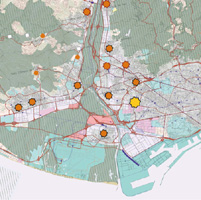Sprawl in Barcelona Region and the PTMB 2010
Abstract
The Barcelona metropolitan region is composed of 164 municipalities distributed over an area of about 3234 sq km with a population of 5 million inhabitants. In the last decades, the growth of metropolitan region has been characterized by some critical problems: high land occupation, dispersed occupation of the territory, low building density, considerable fragmentation and high specialization (residential developments, commercial centers, industrial areas, etc), growing social segregation.
The sprawl, together with changes in economic and social structure, caused a loss of landscape and environment values in the territory, a reduction of natural areas, involving an increase in consumption of resources.
The sprawling development was already evident in the early 1970s, and a study of dynamic of the sprawl was conducted to show the main features of this process. The morphology of discontinuity, fragmentation and heterogeneity are common features of the metropolitan regions in Southern Europe. The changes from the traditional compact city to a dispersed one caused important effects in the functioning of the territories and in the lifestyles of their users.
The main problems addressed by the plan have been identified in the sprawl, the territorial fragmentation and the growing social segregation.
The adoption of the Barcelona Metropolitan Plan is a notable innovation in the scenario of spatial planning and urban policies in Catalonia. In fact, the PTMB, that comes to close more than 40 years of controversy and failed attempts, presents some aspects of particular interest and represents a planning tool providing a methodology for administrative and political management for the future.
The plan has been proposed by regional government in concert with municipalities through an interesting participatory process that has secured a broad consensus.
The plan structure founded on three main systems: Open Spaces, Settlements and Infrastructures; all of them providing strategic solutions and detailed analysis of the different parts of territory , in order to reach a balanced future asset.
Downloads
References
Acierno A., Mazza A. (2011) Governare la metropoli. Il Piano Territoriale Metropolitano di Barcellona, Edizioni Scientifiche Italiane, Napoli
Bonomi A., Abruzzese A. (2004) La città infinita, Mondatori, Milano,
Borja J. (2009) Luces y sombras del urbanismo en Barcelona, Barcelona, Universitat Oberta de Cataluña
Camagni R., Gibelli M.C., Rigamonti P. (2002) I costi collettivi della città dispersa, Alinea, Firenze
Castells M. (2004) La città delle reti, Marsilio Editori, Venezia
Esteban J. (2009) “La pianificazione territoriale in Catalogna”, TRIA - Rivista internazionale semestrale di cultura urbanistica, n. 3, Edizioni Scientifiche Italiane, Napoli
Font A., Carrera J.M. (2005) Transformacions urbanitzadores. Àrea metropolitana i regió urbana de Barcelona, Barcelona, Àrea Metropolitana de Barcelona
Indovina F. (ed.), (2011) La ciudad de baja densidad. Lógicas, gestión y contención, Barcelona, Diputación de Barcelona
Indovina F. (2009) Dalla città diffusa all'arcipelago metropolitano, Franco Angeli, Milano
Indovina F. (a cura di), (1999) Barcellona. Un nuovo ordine territoriale, Franco Angeli, Milano
Ingersoll R. (2004) Sprawltown, Meltemi, Roma
López J. (2003) La mobilitat de les persones a la regió metropolitana de Barcelona, in Papers. Regió Metropolitana de Barcelona, 38
Nel-lo O. (2001) Ciutat de ciutats. Reflexions sobre el procés d’urbanització a Catalunya, Empuries, Barcelona
Nel-lo O. (2005) “La Nuova Politica Territoriale della Catalogna”, Archivio di Studi Urbani e Regionali n. 83, II quadrimestre 2005, Venezia
Nel-lo O. (2007) “La tercera fase de metropolitanización en España”, in Rullán O. (ed.), Los procesos urbanos postfordistas, Asociación de Geógrafos Españoles, Mallorca
Nel-lo O. (2011); “La ordenación de las dinámicas metropolitanas. El Plan Territorial Metropolitano de Barcelona”, in Scripta Nova. Revista electrónica de Geografía y Ciencias Sociales
Rueda S. (2002) “Els costos ambientals dels models urbans dispersos”, Papers. Regió Metropolitana de Barcelona, 36

Copyright (c) 2014 Tema. Journal of Land Use, Mobility and Environment

This work is licensed under a Creative Commons Attribution 4.0 International License.
Authors who publish in this journal agree to the following:
1. Authors retain the rights to their work and give in to the journal the right of first publication of the work simultaneously licensed under a Creative Commons License - Attribution that allows others to share the work indicating the authorship and the initial publication in this journal.
2. Authors can adhere to other agreements of non-exclusive license for the distribution of the published version of the work (ex. To deposit it in an institutional repository or to publish it in a monography), provided to indicate that the document was first published in this journal.
3. Authors can distribute their work online (ex. In institutional repositories or in their website) prior to and during the submission process, as it can lead to productive exchanges and it can increase the quotations of the published work (See The Effect of Open Access)
